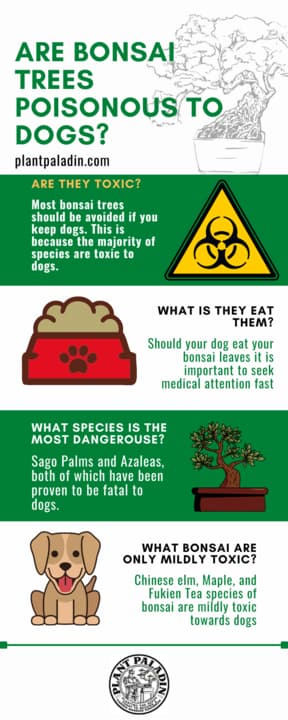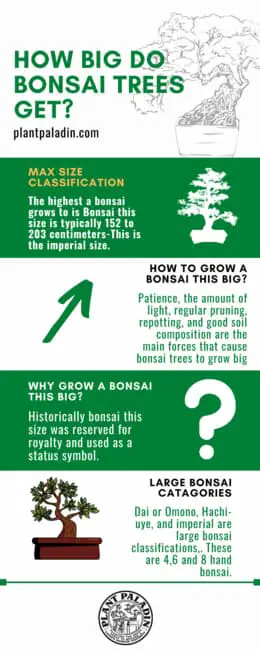This website is supported by its readers. If you click one of my links I may earn a commission. I am also a participant in the Amazon affiliates program and I will also earn a commission from qualified purchases.

Anyone who’s owned a dog knows just how messy they can be. Whether it’s shedding their hair, chewing cables, or doing their dirty business in your neighbor’s front garden. One of the things we have to watch out for when owning dogs is if we keep bonsai. So are bonsai trees dog friendly?
Most bonsai tree species are not dog friendly and should be avoided if you own a dog. Some bonsai contain toxins that when ingested can cause your dog to become sick. Avoid Sago Palms, Azaleas at all costs as they can prove fatal for dogs.
So which bonsai plant species are the most toxic and which bonsai species can live in harmony with your canine, Keep reading to find out more!
Just a quick heads up, over the past three years of running Plantpaladin, hundreds of people have asked for product recommendations. As such, You can find my favorite indoor bonsai tree here (link takes you to Bonsaiboy), my favorite outdoor bonsai tree (link takes you to Bonsaiboy), or have a look at all the products I recommend here.
Bonsai trees and dogs
Owning a bonsai tree and dogs can prove a tricky relationship to manage.
Dogs are naturally curious and so starting a new hobby like bonsai can be challenging.
Especially as most bonsai species are toxic at the very least to poisonous at the most to dogs.
Are bonsai trees poisonous to dogs?
I’ve called up the RSPCA, surveyed a few of the plant paladin readers, visited a few garden centers to get to the bottom of living with bonsai trees and dogs.
To summarize:
- Most bonsai trees should be avoided if you keep dogs.
- This is because the majority of species are toxic to dogs.
- Should your dog eat your bonsai it is important to seek medical attention fast – usually by calling up your vet or an emergency line such as ASPCA Poison Center on 1-888-426-4435.
- Different plants have different toxins which will cause your dog to react differently.
- Some bonsai will merely cause your dog to be more lethargic or have an upset stomach such as Chinese Elm
- Whereas other species such as Azalea can prove fatal
- The amount of the tree your dog will eat can also prove fatal depending on the species.
- If small amounts are ingested most dogs will be okay compared to eating multiple toxic trees.
- The size and breed of your dog will also matter with some larger dog breeds needing to ingest more bonsai to feel the full effects.
- Bonsai trees you should always avoid are Sago Palms and Azaleas, both of which have been proven to be fatal to dogs.
- Should you decide to keep bonsai trees, keep them indoors in a separate room from your dog or in a purpose-built bonsai greenhouse or cold frame that your dog does not have access to.
- Almost any form of ingesting bark or tree wood will cause diarrhea or an upset stomach to dogs.
- Bonsai owners typically own moss too either for decorative or moisture purposes. This too should be avoided with some mosses also proving toxic for dogs.
What happens if a dog eats a bonsai tree?
Should a dog ingest a toxic bonsai it will start to experience serious side effects such as vomiting, diarrhea, rashes, gastrointestinal pain, irregular heartbeat, dizziness, excessive drooling, temporary blindness, and in extreme cases death.
The range of side effects will vary on the type of bonsai your dog has consumed with some bonsai species being more fatal than others.
That being said, as a dog owner you should avoid your dog being in the same room as bonsai with some of these side effects such as rashes being passed on through touch as opposed to direct consumption.
What to do if your dog has eaten a bonsai?
If you think your dog has consumed a bonsai tree, take note of what species the tree was and call up your local or emergency vet immediately. Avoid treating the dog yourself by getting the dog to throw up unless directly instructed to do so by a vet.
A few details then you should keep nearby if you own a do are as follows:
- Vets Now
- Pet Helpline (UK)
- Pet Poison Helpline ( 24hr USA)
- ASPCA Poison Center – 1-888-426-4435
Are bonsai trees poisonous to dogs?
Bonsai trees, as you are likely aware, are not just made up of one species of plant but several species.
Technically you can make a bonsai from any plant or shrub, so long as you care for it correctly.
As such the trees and plants that are toxic to dogs normally will still be poisonous even in bonsai form.
Azalea, Sago Palm, Ficus, Jade, Cherry, Apricot, and Boxwood bonsai species are all toxic to dogs and should be avoided. Pine species may also cause some irritation due to their needles so junipers and other evergreens should also be avoided.
Now there are thousands of species of bonsai out there made up of a variety of different plants.
Luckily, however, I’ve pulled together a comprehensive list below.
Should your bonsai plant species not appear on this list, you should still research to see if that plant is allergic to dogs.
The following tree/plant species then should be avoided:
- Allium species
- Amaryllis bulbs
- Ambrosia Mexicana
- Apricot
- Asparagus fern
- Australian Ivy Palm
- Australian Pine
- Azalea
- Boxwood
- Buddhist Pine
- Cardboard Palm
- Coontie Palm
- Cherry
- Cyclamen
- Cycad
- Daffodil bulbs
- Delphiniums
- Ficus
- Fig
- Foxgloves
- Giant Dracaena
- Hemlock
- Hyacinth
- Hydrangea
- Ivy
- Jade
- Juniper (both Chinese and Japanese)
- Laburnum
- Lily species
- Lupin
- Morning glory
- Norfolk Island Pine
- Nightshade
- Oleander
- Pine
- Rhododendron
- Rhubarb leaves
- Sago Palm
- Sweet pea
- Tulip bulbs
- Umbrella Trees
- Wisteria
- Yew
Why are some bonsai trees toxic to dogs?
Most bonsai plant species are toxic to dogs due to the leaves and bark of the tree. Plants contain toxic chemicals such as saponin which is used for basic tree function but also as a defense mechanism to avoid predators from eating them.
Luckily most of us bonsai owners tend to only opt for a few key species of bonsai which are available globally and are the most common.
These include:
- Azalea
- Sago Palm
- Ficus
- Jade
- Cherry
- Apricot
- Boxwood
- Giant Dracaena
- Fig
- Umbrella trees
- Chinese Elm
- Juniper
- Maple
- Fukien Tea
- Wisteria
- CotonEaster
Let’s explore these in a table down below:
| Bonsai Species | Degree of Severity |
| Azalea | Severe |
| Sago Palm | Severe |
| Ficus | Moderate |
| Jade | Moderate |
| Cherry | Moderate |
| Apricot | Moderate |
| Boxwood | Moderate |
| Giant Dracaena | Severe |
| Fig | Moderate |
| Umbrella trees | Moderate |
| Chinese Elm | Mild |
| Juniper | Mild |
| Maple | Mild |
| Fukien Tea | Mild |
| Wisteria | Moderate |
| Cotoneaster | Moderate |
Now in terms of general symptoms, these bonsai will have the following effects on your dogs:
| Bonsai Species | Degree of Severity | Symptoms |
| Azalea | Severe | Vomiting, difficulty breathing, death |
| Sago Palm | Severe | Vomiting, difficulty breathing, death |
| Ficus | Moderate | Skin irritation when touched, stomach upset when ingested |
| Jade | Moderate | Gastric distress, Heartbeat Irregularities, Depression |
| Cherry | Moderate | Gastric distress – can prove fatal if the seeds have been eaten as they contain cyanide. |
| Apricot | Moderate | Seeds can prove fatal as they contain cyanide. |
| Boxwood | Moderate | Dehydration, Vomiting, Diarrhea |
| Giant Dracaena | Severe | Depression, heart irregularities, death if eaten in large quantities |
| Fig | Moderate | Drooling, diarrhea, Watery eyes, abdominal pain. |
| Umbrella trees | Moderate | Drooling, diarrhea, Watery eyes, abdominal pain. |
| Chinese Elm | Mild | Upset stomach if the bark or leaves are eaten |
| Juniper | Moderate | Upset stomach if the bark or leaves are eaten |
| Maple | Mild | Upset stomach if the bark or leaves are eaten |
| Fukien Tea | Mild | Upset stomach if the bark or leaves are eaten |
| Wisteria | Moderate | Seeds and pods can be poisonous if ingested in large quantities causing dehydration and collapse. |
| Cotoneaster | Moderate | Upset stomach if seeds or cherries are eaten. |
Now as mentioned because bonsai is not one species, but multiple different species, let’s break down the 16 trees laid out above in more detail:
For a more detailed list check out the ASPCA post on a list of toxic plants to animals.
What bonsai trees are the most poisonous for dogs?
Sago Palm, Azalea, and Giant Dracena are the most dangerous bonsai species to own if you have a dog. Consumption of these plants by your dog will cause it to fall in with Sago Palm in particular often being lethal in doses as small as 0.2% of your dog’s body size.
Seek immediate medical help if you think your dog has consumed these bonsai species.
Let’s go into detail in these individually and see the symptoms, treatment, and aftercare for these plants.
Is Azalea bonsai poisonous to dogs?

Azalea or Rhododendron bonsai are one of the most toxic and poisonous species for dogs. Symptoms typically occur within a few hours and a toxic dose in dogs is only 0.2% of the dog’s size. You should call your vet immediately if your dog has ingested azalea bonsai.
Azaleas (also known as Rhododendron) often make for great bonsai, they bloom bright pink flowers in the spring months and really make any bonsai collection pop.
Sadly however these bonsai are incredibly dangerous and have a very high toxicity level towards dogs.
Symptoms of Azalea bonsai poisoning in dogs
The main symptoms of Azalea poisoning include:
- Stomach pain
- Diarrhea
- Vomiting
- Abnormal heart rate
- Drooling
- Lethargy
- Seizures
- Low blood sugar
- Temporary blindness
- Death
All parts of the Azalea plant will be toxic to dogs but be especially wary during the spring months when flowers start to bloom which dogs will have a habit of wanting to eat.
How to treat azalea bonsai poisoning in dogs?
So now we know what azalea poisoning symptoms look like, how do you treat your dog if it has ingested an azalea bonsai?
When taking your dog to the vets there are a few main treatments they will give for azalea poisoning. As always with any kind of poisoning, the faster you get your dog to the vet the higher chance of success you may have.
These include:
Stomach pump – To remove the toxins if they have recently been eaten.
Induced Vomiting – Common method used for most toxins in dogs. If your dog has no symptoms or is not dehydrated this is the method of choice. Vets will use either dog ipecac or hydrogen peroxide.
IV Line – Used in the recovery process to ensure your dog has the minerals it needs in recovery. Also used to flush the kidneys of your dogs.
Repository support – Should your dog’s lungs be infected or its heart rate drops too low then this method is used to help stabilize your dog.
How long does it take to recover?
Should you get to the vet early enough recovery will typically take around 24 hours if small amounts of azaleas have been eaten by your dog.
Should your dog have eaten much larger quantities of azalea then you can expect the recovery to take a few weeks up to a month.
A dog’s age and overall health will also play a vital role in the recovery of your dog from azalea bonsai poisoning.
Is sago palm bonsai poisonous to dogs?
Sago palm bonsai is one of the most poisonous bonsai species for dogs. All parts of the bonsai can be lethal if ingested with the plant’s seeds typically having the most potent toxins. Sago Palm bonsai then should be avoided at all costs if you own a dog.
Now whilst sago palm trees are not all that common in bonsai use, they can be found in larger bonsai collections – particularly in warmer or tropical climates.
Sadly with Sago Palm bonsai, all aspects of the trees are toxic with the leaves often causing severe reactions.
What’s even worse is sago palm bonsai are toxic to all types of animals and have an incredibly high toxicity rate so should be avoided at all costs should you live with any animals.
Symptoms usually start within 15 minutes of ingesting large quantities but can take a few hours or even days.
Symptoms of sago palm bonsai poisoning in dogs?
The main symptoms to keep an eye out for when it comes to sago palm bonsai poisoning in dogs include:
- Death
- Liver failure
- Coma
- Stomach pain
- Vomiting and bloody vomiting
- Diarrhea and bloody diarrhea
- Seizures
- Liver failure
- Dehydration
Now the key with this is to act fast with Sago Palm often being a lot more aggressive in the time needed for these side effects to occur than the other plants on this list.
How to treat sago palm bonsai poisoning in dogs?
As always, should you suspect your dog has ingested or even been close to sago palm, your first point of contact should be to see a vet or emergency vet.
They will usually do the following method to treat your dog:
Antibiotics – can be used to help control seizures, dehydration, or counter any viral infections brought about through eating sago palm.
Induced vomiting – a common method used for most toxins in dogs. If your dog has no symptoms or is not dehydrated this is the method of choice. Vets will use either dog ipecac or hydrogen peroxide.
Stomach pump – to remove the toxins if they have recently been eaten.
Blood transfusions – used in serious cases of liver disease or failure brought about by the toxins.
How long does it take to recover?
Sadly only around 50% of dogs end up surviving should they eat sago palm.
As such, it’s super important that you go to the vets as soon as you become aware of the issue.
Even if your dog survives, long-term recovery can take weeks or months and the long-term prognosis on dogs is that they can end up developing related health issues such as liver damage or disease.
Is giant dracaena bonsai poisonous to dogs?
Giant dracaena bonsai is poisonous to dogs. This is because of the saponin contained in the leaves of the plant. The main symptoms include vomiting, diarrhea, weakness, drooling, loss of appetite, and depression.
Similar to sago palm, giant dracaena is not a bonsai that is all that common.
It is however incredibly dangerous to keep around the house and should be avoided.
Whilst not necessarily fatal it will cause a great deal of discomfort hence why it is under the severe category.
Symptoms of giant dracaena bonsai poisoning in dogs?
The main symptoms of giant dracaena bonsai poisoning include:
- Vomiting or bloody vomiting
- Diarrhea or bloody diarrhea
- Weakness
- Drooling
- Loss of appetite
- Depression
How to treat giant dracaena bonsai poisoning in dogs?
The main treatments given to dogs to treat poisoning by giant dracaena are:
Induced Vomiting – Common method used for most toxins in dogs. If your dog has no symptoms or is not dehydrated this is the method of choice. Vets will use either dog ipecac or hydrogen peroxide.
Fluid treatments – IV lines are usually fitted to flush the kidneys and restore any minerals lost through diarrhea or vomiting.
Activated Charcoal – Usually the final step used to absorb any lacking toxins left behind from the other treatments.
How long does it take to recover?
Most dogs will be able to recover within 24 hours of receiving treatment.
Some severe cases however will require hospital observation for any further 24 hours.
What bonsai trees are moderately poisonous for dogs?
So now we have explored the most severe types of plants that can cause poisoning, what about bonsai species that have some moderate side effects with dogs?
Ficus, Jade, Cherry, Apricot, Boxwood, Fig, Umbrella Tree, wisteria, and Cotoneaster bonsai species are all frequently bought bonsai that are poisonous to dogs. Whilst consumption of these is not likely to be lethal, large doses can be severe.
Consult your vet if you think your dog has consumed these species.
As bonsai come in thousands of different species you must check some dogs are the toxicity of your plant before bringing it into your home
Is ficus bonsai poisonous to dogs?
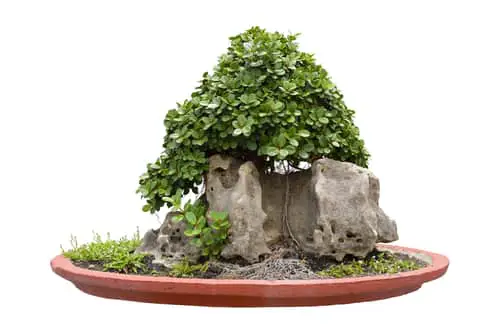
Ficus bonsai are moderately toxic to dogs. The leaves in the tree can cause gastrointestinal issues in dogs and the leaves can also cause rashes. Ficus bonsai is not likely to be lethal to dogs.
Symptoms of ficus bonsai poisoning in dogs?
The main symptom of ficus bonsai poisoning in dogs includes:
- Skin rashes
- Diarrhea
- Vomiting
- Lethargy
- Drooling
- Mouth salivation
- Fluctuating heart rate
- Stomach pain
How to treat ficus bonsai poisoning in dogs?
Ficus poisoning is usually mild and will typically resolve itself within 24 hours.
In more serious cases observation may be required.
Typically then a vet will opt for the following methods of treatment:
Induced Vomiting – a common method used for most toxins in dogs. If your dog has no symptoms or is not dehydrated this is the method of choice. Vets will use either dog ipecac or hydrogen peroxide.
Fluid treatments – IV lines are usually fitted to flush the kidneys and restore any minerals lost through diarrhea or vomiting.
How long does it take to recover?
Most dogs will be able to recover within 24 hours of receiving treatment.
Some severe cases however will require hospital observation for any further 24 hours.
Is jade bonsai poisonous to dogs?
Jade bonsai is toxic to dogs. Most symptoms are usually mild, however more advanced side effects if a lot of jade is consumed include stomach pain, vomiting, lethargy, depression, and anxiety.
In more extreme cases some dogs have had irregular heartbeats due to jade poisoning.
Symptoms of jade bonsai poisoning in dogs?
The main symptoms of extreme jade bonsai include:
- Diarrhea
- Vomiting
- Lethargy
- Fluctuating heart rate
- Stomach pain
- Gastric distress
- Anxiety
- depression
How to treat jade bonsai poisoning in dogs?
Most jade bonsai points are also mild. As such the main treatment often given will be observed.
In more serious cases however vets may opt for the following methods of treatment:
Digestive system cleanses – In extreme cases of jade poisoning, a vet will put your dog under anesthetic, then flush its digestive system through a tube with warm saline. This tube will be put down the throat of your dog so it can sometimes be distressing to watch.
Induced vomiting – Common method used for most toxins in dogs. If your dog has no symptoms or is not dehydrated this is the method of choice. Vets will use either dog ipecac or hydrogen peroxide.
Fluid treatments – IV lines are usually fitted to flush the kidneys and restore any minerals lost through diarrhea or vomiting.
How long does it take to recover?
Most dogs will recover even under the most serious condition of jade poisoning without any major side effects.
With mild side effects and symptoms expect your dog to fully recover within 24 hours to 1 week.
Is cherry bonsai poisonous to dogs?
Cherry bonsai is toxic to dogs. Most symptoms are usually mild, however more advanced side effects can happen if dogs eat the seed of the cherry fruit. This contains cycasin which can cause liver failure within 15 minutes.
Symptoms of cherry bonsai poisoning in dogs
The main symptoms of extreme cherry bonsai include:
- Diarrhea
- Vomiting
- Black stool
- Lethargy
- Liver failure (in extreme cases)
How to treat cherry bonsai poisoning in dogs?
Most cherry bonsai symptoms are mild.
Vets then will typically do the following:
Induced vomiting – Common method used for most toxins in dogs. If your dog has no symptoms or is not dehydrated this is the method of choice. Vets will use either dog ipecac or hydrogen peroxide.
Fluid treatments – IV lines are usually fitted to flush the kidneys and restore any minerals lost through diarrhea or vomiting.
In more rare cases however where many cherry seeds have been eaten by the dog emergency surgery may be required.
Left uncheck liver failure can occur.
How long does it take to recover?
Mild cases will recover in a week, but more severe cases with liver conditions can cause complications meaning full recovery time can take a few months.
Should your dog’s livers be damaged by the cherry seeds then they may require medication or treatment for the rest of their lives.
Is Apricot bonsai poisonous to dogs?
Apricot bonsai is toxic to dogs. Most symptoms are usually mild, however more advanced side effects can happen if dogs eat the seed or stones in apricot fruit which contain amygdalin which converts to cyanide when eaten.
Symptoms of apricot bonsai poisoning in dogs
- Diarrhea
- Vomiting
- Black stool
- Lethargy
- Liver failure (in extreme cases – of the seeds of the fruit are eaten)
- Death (in extreme cases – of the seeds of the fruit are eaten)
It’s also worth mentioning that apricot seeds are also dangerous to humans so take extra care when handling them.
How to treat apricot bonsai poisoning in dogs?
Mild forms of apricot bonsai poisoning in dogs (i.e if your dog has only eaten the bonsai and not the fruit or seeds) will be treated in the following ways:
Induced vomiting – Common method used for most toxins in dogs. If your dog has no symptoms or is not dehydrated this is the method of choice. Vets will use either dog ipecac or hydrogen peroxide.
Fluid treatments – IV lines are usually fitted to flush the kidneys and restore any minerals lost through diarrhea or vomiting.
More extreme cases will be treated with:
Digestive system cleanses – in extreme cases of apricot poisoning, a vet will put your dog under anesthetic, then flush its digestive system through a tube with warm saline. This tube will be put down the throat of your dog so it can sometimes be distressing to watch.
However, the most serious of all will be if your dog has eaten the seeds of the apricot, this can prove fatal, and the sooner you call your vet, the higher chance of recovery you will have.
How long does it take to recover?
Mild cases will recover in a week, but more severe cases will result in long-term liver conditions that can cause complications, meaning full recovery time can take a few months.
Should your dog’s livers be damaged by the apricot seeds then they may require medication or treatment for the rest of their lives.
Is boxwood bonsai poisonous to dogs?
All species of boxwood bonsai are poisonous not only to dogs but to humans and other pets as well. Boxwood bonsai can cause breathing difficulties, dizziness, vomiting, and diarrhea in dogs.
Symptoms of boxwood bonsai poisoning in dogs
- Diarrhea
- Vomiting
- Depression
- Lethargy
- Fluctuating heart rate
- Stomach pain
- Gastric distress
- Anxiety
- Depression
How to treat boxwood bonsai poisoning in dogs?
Despite boxwood bonsai having several side effects should they be ingested by dogs, the main treatment will be the same as it is for many other bonsai.
The main treatments then are
Induced vomiting – A common method used for most toxins in dogs. If your dog has no symptoms or is not dehydrated this is the method of choice. Vets will use either dog ipecac or hydrogen peroxide.
Fluid treatments – IV lines are usually fitted to flush the kidneys and restore any minerals lost through diarrhea or vomiting.
How long does it take to recover?
Mild cases will recover in a week.
More severe cases may need a few extra days of observation but most boxwood bonsai cases should usually be resolved in 2 weeks.
Is juniper bonsai poisonous to dogs?
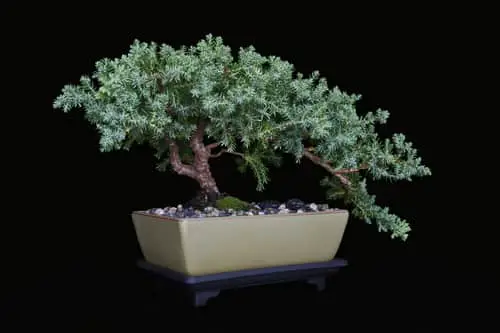
Jumper bonsai is toxic to dogs. Whilst they do not cause fatalities in dogs the leaves are toxic which can cause your dog to vomit, have diarrhea, stomach discomfort, or dizziness. The needles of junipers are also dangerous with the potential for your dog to suffocate on the needles.
Symptoms of juniper bonsai poisoning in dogs
- Diarrhea
- Vomiting
- Stomach pain
- Gastric distress
How to treat juniper bonsai poisoning in dogs?
With juniper bonsai being so common, and the plant being non-fatal, vets will usually treat the following ways:
Observation – most dogs who eat juniper are observed over a 24 to 48 hour period to get rid of the toxins naturally.
Induced vomiting – more serious cases will use induced vomiting. It is a common method used for most toxins in dogs. If your dog has no symptoms or is not dehydrated this is the method of choice. Vets will use either dog ipecac or hydrogen peroxide.
How long does it take to recover?
Mild cases will recover in a week.
More severe cases may need a few extra days of observation but most juniper bonsai cases should usually be resolved in 2 weeks.
Is fig bonsai poisonous to dogs?
Fig bonsai and other ficus species are toxic to dogs. This is from a white sap on the leaves that can cause stomach pain, vomiting, and diarrhea when ingested or rashes when touched.
Symptoms of fig bonsai poisoning in dogs
- Diarrhea
- Vomiting
- Stomach pain
- Gastric distress
How to treat fig bonsai poisoning in dogs?
Observation – Most dogs who eat juniper are observed over a 24 to 48 hour period to get rid of the toxins naturally.
Induced vomiting – More serious cases will use induced vomiting. It is a common method used for most toxins in dogs. If your dog has no symptoms or is not dehydrated this is the method of choice. Vets will use either dog ipecac or hydrogen peroxide.
How long does it take to recover?
Mild cases will recover in a week.
More severe cases may need a few extra days of observation but most fig cases should usually be resolved in 2 weeks.
Is umbrella tree bonsai poisonous to dogs?
Umbrella tree bonsai is poisonous to dogs in all forms. This is because it contains insoluble calcium oxalates, saponins, and terpenoids (aromatic hydrocarbon chemical substances) all of which can cause severe drooling swelling of the face, vomiting diarrhea, and gastrointestinal upset.
Symptoms of umbrella tree bonsai poisoning in dogs
- Diarrhea
- Vomiting
- Stomach pain
- Gastric distress
- Swelling of the face
- Excess drooling
- Swelling of the mouth and gums
- Agitation
- Pacing
How to treat umbrella tree bonsai poisoning in dogs?
Digestive system cleanses – in extreme cases of umbrella tree poisoning, a vet will put your dog under anesthetic, then flush its digestive system through a tube with warm saline. This tube will be put down the throat of your dog so it can sometimes be distressing to watch.
Induced vomiting – more serious cases will use induced vomiting. It is a common method used for most toxins in dogs. If your dog has no symptoms or is not dehydrated this is the method of choice. Vets will use either dog ipecac or hydrogen peroxide.
Fluid treatments – IV lines are usually fitted to flush the kidneys and restore any minerals lost through diarrhea or vomiting.
How long does it take to recover?
Mild cases will recover in a week.
More severe cases may need a few extra days of observation but most umbrella tree cases should usually be resolved in 2 weeks.
Is wisteria bonsai poisonous to dogs?
Wisteria bonsai and more specifically wisteria seeds are highly toxic to dogs. If a dog ingests wisteria seeds then it will begin to dehydrate. Feel lethargic and eventually collapse.
Symptoms of wisteria bonsai poisoning in dogs
- Stomach pain
- Gastric distress
- Dehydration
- Collapse
How to treat wisteria bonsai poisoning in dogs?
Induced vomiting – More serious cases will use induced vomiting. It is a common method used for most toxins in dogs. If your dog has no symptoms or is not dehydrated this is the method of choice. Vets will use either dog ipecac or hydrogen peroxide.
Fluid treatments – IV lines are usually fitted to flush the kidneys and restore any minerals lost through diarrhea or vomiting.
How long does it take to recover?
Mild cases will recover in a week.
Is cotoneaster bonsai poisonous to dogs?
Cotoneaster bonsai or more specifically cotoneaster bonsai berries are poisonous to dogs. If large quantities are ingested by your dog it will cause severe gastrointestinal upset such as vomiting and diarrhea.
Symptoms of cotoneaster poisoning in dogs
- Stomach pain
- Gastric distress
- Vomiting
- diarrhea
- Dehydration
- Collapse
How to treat Cotoneaster poisoning in dogs?
Induced vomiting – More serious cases will use induced vomiting. It is a common method used for most toxins in dogs. If your dog has no symptoms or is not dehydrated this is the method of choice. Vets will use either dog ipecac or hydrogen peroxide.
Fluid treatments – IV lines are usually fitted to flush the kidneys and restore any minerals lost through diarrhea or vomiting.
How long does it take to recover?
Mild cases will recover in a week.
More severe cases where a lot of berries or seeds have been eaten will require a much longer time in observation.
What bonsai tree species are mildly poisonous to dogs?

What about bonsai species that are mildly toxic to dogs? The good news is that most of these species are treated the same way.
Chinese Elm, Juniper Maple, and Fukien Tea bonsai species are not likely to be fatal unless consumed in large doses. These species however will cause your dog discomfort such as diarrhea and vomiting if they consume the bark or leaves.
Always consult a vet if you feel your dog has consumed bonsai.
All bonsai tree species have some degree of toxicity towards dogs. Being vigilant to avoid your dog consuming bonsai is the best option to avoid your dog getting ill.
Fern palm bonsai are also considered to be non-lethal to dogs.
Should these symptoms worsen see your vet immediately.
It’s worth noting that even the mildest plants used for bonsai will have a lot of similar effects to the above species so always be vigilant when keeping your dog around or near bonsai.
Which dog breeds are allergic to bonsai?
Whilst all dog breeds will fall ill if they consume bonsai, larger, greedy breeds such as Labradors, Retrievers, Springer Spaniels, Shiba Inus, and Poodle Crosses will be harder to control. This makes them more likely to eat the foliage of their own free will and more susceptible to fall ill.
A good rule of thumb to follow is the harder and more independent a dog is the greater chance there will be for the dog to eat your bonsai whenever it gets hungry.
What breeds of dogs are more susceptible to eating bonsai?
The following dog breeds are notorious for being greedy when it comes to food, more intelligent and so more difficult to train.
Should you own a bonsai you might want to reconsider letting your dog near these:
- Shiba Inus
- Beagles
- Rottweiler
- Siberian Husky
- Basset Hound
- Bloodhound
- Chinese Shar-pei
- Afghan Hound
- Old English Sheepdogs
- Great Pyrenees
- Saint Bernards
- Bull Terrier
- Chihuahua
- Shih Tzus
- Mastiff
- Pekingese
- Borzois
- Chow Chow
- Bulldog
- Basenji
Now there are also a ton of other breeds of dog that are susceptible to eating bonsai grass and other types of greenery so be sure to check in with your vet.
Source: Barkpost, Countrylife
What breed of dog should you own if you own bonsai?
German Shepherds, Doberman Pinscher, Border Collie, and Belgian Shepard Dogs are the best dog breeds you should own if starting bonsai. This is because these dogs are easy to train, and if given the right instruction, will avoid eating your trees which can cause your dog to fall ill.
While all dog breeds will fall ill if they consume specific bonsai species, there are some dogs that are more well behaved, more likely to follow commands, and less likely to eat bonsai.
These include:
- Border Collie
- German Shepherd
- Doberman Pinscher
- Shetland Sheepdog
- Labrador retriever
- Papillon
- Australian Cattle Dog
- Pembrokeshire Welsh Corgi
- Belgian Shepherd Dog
Source: Newsweek
Can you treat your dog yourself if it eats bonsai?
Should you find that your dog has consumed a bonsai tree, regardless of the species, your first point of contact should be to go to your vet as opposed to treating your dog yourself.
You see, some bonsai species such as Sago Palm can be fatal if a dog consumes as little as 0.2% their body size.
Again, a few details then you should keep nearby if you own a dog but also have bonsai as a hobby are as follows:
- Vets Now
- Pet Helpline (UK)
- Pet Poison Helpline ( 24hr USA)
- ASPCA Poison Center – 1-888-426-4435.
How much bonsai tree can a dog eat without getting side effects?
Eating something as small as a teaspoon of a bonsai tree can wreak havoc on your dog’s digestive system, causing severe side effects such as vomiting, diarrhea, and in severe cases death. Some bonsai such as sago palm can be fatal should your dog consume 0.2% of their body weight of that plant.
The larger your dog then, the greater chance you have of your pet surviving.
One of the things then that you can do is only invest in smaller fingertip size bonsai.
Bonsai size classification can be a tricky concept to understand for new bonsai owners so to help find out more check out my post here or have a look at the graph below.
| Classification | Size inches | Size Centimeters | Hand size | General size |
| Keshitsubo | 1 to 3 inches | 3 to 8 centimeters | Fingertip | Tiny |
| Shito | 2 to 4 inches | 5 to 10 centimeters | One-hand | Tiny |
| Mame | 2 to 6 inches | 5 to 15 centimeters | One-hand | Small |
| Chohin | 5 to 8 inches | 13 to 20 centimeters | One-hand | Small |
| Kumono | 6 to 10 inches | 15 to 25 centimeters | One-hand | Small |
| Katade-mochi | 10 to 18 inches | 25 to 46 centimeters | Two-hand | Medium |
| Chiu or Chumono | 16 to 36 inches | 41 to 91 centimeters | Two-hand | Medium |
| Dai or Omono | 30 to 48 inches | 76 to 122 centimeters | Four-hand | Large |
| Hachi-uye | 40 to 60 inches | 102 to 152 centimeters | Six-hand | Large |
| Imperial | 60 to 80 inches | 152 to 203 centimeters | Eight-hand | Large |
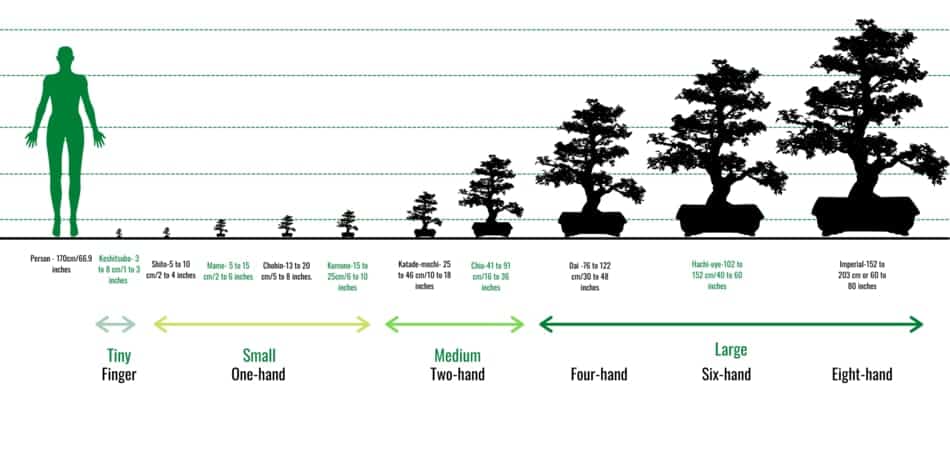
How to keep a bonsai tree when you have a dog?
So if you do want to keep a dog as well as cultivate and grow bonsai don’t fret.
Whilst it will take a little more patience and practice, there are a few quick steps you can follow to ensure your dog stays safe.
These include:
- Make a list of emergency numbers
- Take note of all the bonsai species you own and their side effects
- Opt for less toxic bonsai species
- Keep your bonsai outdoors
- Or keep your bonsai in a separate room
- Invest in a bonsai greenhouse
- Keep fertilizer or other tools away from your dog’s grasp
- Only water your bonsai when your dog is not present
- Maintain and prune your bonsai when your dog is not around
Let’s explore these below
Make a list of emergency numbers
So the first thing I think all dog owners should do is make a list of emergency contacts.
Having your vet number saved on your phone or a note will give you one less thing to worry about if your dog does eat bonsai.
It’s also worth having some emergency or out-of-hours vets numbers located in the same place in case you can’t reach your vet or they are on vacation.
Take note of your bonsai species
Taking note of what bonsai species you own and what their side effects are can make all the difference.
If you own multiple bonsai and own a few dangerous species such as azalea then you know how serious the side effects will be.
Alternatively, if you own the likes of Chinese elm you know that whilst they can be toxic, you will have more time to deal with your dog ingesting the plant.
Again I would note this on your phone or a notebook – feel free to run through the side effects listed out earlier in this post for the most common bonsai species.
Opt for less toxic bonsai species
If you found that through reading this post, the bonsai in your collection are all extremely toxic, then it might be time to sell them and invest in less toxic bonsai species.
Plants like Fern Palms make for great bonsai and most people consider these plants dog safe.
Keep your bonsai outdoors
Another recommendation that works well if you have a dog is to keep your bonsai outdoors.
Whilst the majority of you let your dog outdoors, most of you will keep your dogs indoors overnight.
Planting your bonsai outdoors in the ground will mean that you won’t have to worry about your dog consuming your bonsai in the middle of the night when you are asleep in the home.
I’d also recommend having a clear barrier so for example, if you have a backyard, only let your dog run around there and keep your bonsai in your front yard or vice versa.
Keep your bonsai in a separate room
Now a lot of us live in apartments and don’t have the luxury of a garden to keep our bonsai in.
If this is the case with you then consider keeping your bonsai indoors in a separate room.
Ensure this room has a lock so your dog can’t get into it.
Ideally, this room should have plenty of windows to ensure your bonsai gets enough light.
Invest in a bonsai greenhouse
One of the best ways I found to have a clear distinction between dogs and your bonsai is to invest in a bonsai greenhouse.
Not only will this maintain the perfect temperature and light conditions for your tree, but you can also easily lock this, meaning your plant will get all the benefits of being outdoors, without you having to worry about your dog eating them.
What’s even better is that you can use a bonsai greenhouse as a cold frame as a way to winterize your bonsai during the cold winter months.
Keep fertilizer or other tools away from your dog
With bonsai, it’s not just the trees themselves that we have to worry about but the tools we use too.
Jin tools, pliers and copper wire can all cause injury to your dog so it’s super important you keep them out of harm’s reach.
If you do use a fertilizer for your plants then ensure that it is pet-friendly fertilizer such as seaweed or fish emulsion.
Water your bonsai when your dog is present
Dog owners know exactly how excited they get when they hear the sound of a hose or water running.
As such, it’s important that tasks you will do daily such as watering is done when your dog can’t see or they are asleep.
Prune your bonsai when your dog is away
The art of bonsai not only required regular watering but also a ton of maintenance and care for defoliation and bonsai ramification.
Dogs usually want their owners’ constant attention, so in the growing season (spring and summer) it’s important that you only do activities like repotting a bonsai when your dog is away.
Trust me when I say it will make the whole process a lot easier.
What bonsai trees are pet-friendly?
Whilst the majority of bonsai trees are toxic not only to dogs but cats and other pet breeds too, there are a few that can be pet friendly.
Fern palm, dogwood, maple, and Chinese elm bonsai are pet-friendly bonsai. Whilst all these will cause some discomfort if ingested, these plant species symptoms are usually minor with dogs and other pets usually recovering quite quickly.
A good list then of bonsai trees to keep if you own pets are:
- Fern Palm
- Dogwood
- Maple
- Chinese Elm
- Purple leaf palm
- Juniper
- Fukien Tree
Are bonsai tree leaves poisonous?
The majority of bonsai tree leaves, branches, roots, and foliage are poisonous to dogs. Different species of bonsai have different levels of toxicity. Plant species with the most toxicity for dogs such as sago palms are toxic from all parts of the tree.
Are evergreen bonsai dogs friendly?
Evergreen bonsai are not dog friendly. This is because a lot of these species such as junipers are moderately toxic to dogs. Evergreen species also have needles that dogs can also choke on.
What do the experts say?
Now I didn’t just want to use my knowledge when it comes to owning a bonsai with dogs but wanted to get some professional advice too.
I visited my local botanical gardens then and this was their response about keeping a bonsai if you want a dog:
“Most bonsai species are toxic for dogs, so if you own a dog, I would keep your bonsai in a separate room or not let your dog in your garden if you keep them outdoors”
I also came across this comment from Dr. Chirstine Long on Petcoach about the toxicity of bonsai:
“Almost any plant (especially bark) can cause gastrointestinal irritation. So yes, it’s possible that eating leaves and bark might make your dog have vomiting and diarrhea.”
Finally, I also surveyed 20 Plant Paladin readers and asked them their thoughts on bonsai trees and dogs – here were the results.
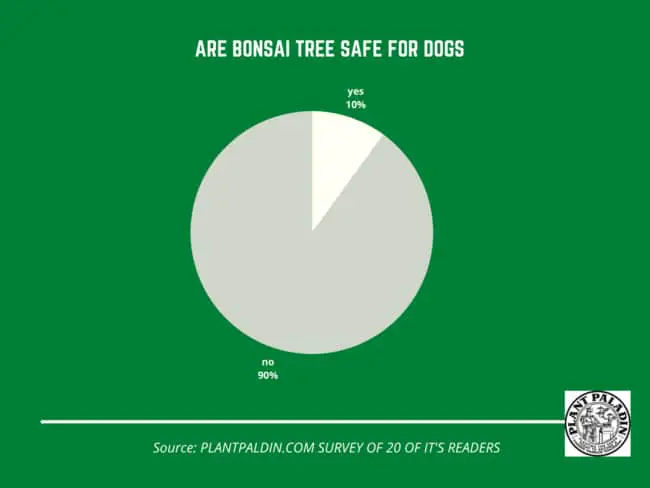
My top picks for the gear you will need!
So like I mentioned earlier, over the past three years of running PlantPaladin, hundreds of people have asked me for my recommendations on the best bonsai gear on the market.
Having spent thousands of dollars on bonsai items these past few years and tested at least 100 bonsai-specific products, I’ve listed my favorite products below – All of which I highly recommend and think you can get great value.
They can purchase directly by clicking the link to take them to Amazon.
Bonsai Tool Set: One of the significant challenges I’ve had is finding a toolset that was not only durable but didn’t break the bank. SOLIGT has recently developed a fantastic bonsai tool set that covers all the tools you need to trim, prune, and repot your trees. – You can grab it here.
Complete Bonsai Set: Many of you will want to grow your bonsai trees entirely from scratch, but finding the varicose seeds, pots, and other items in one place can be challenging. Leaves and Sole then have created a complete bonsai set that I’ve personally used that ticks all the boxes. You can grab it here.
Bonsai wire: The number of times I’ve run out of wire for my bonsai or purchased cheap bonsai wire that doesn’t do the job is embarrassing for me to admit. After a lot of trial and error, I found that using Hotop’s aluminum bonsai wire is one of the best options on the market. This can easily be used for both indoor and outdoor bonsai. You can grab it here.
This post was written by Fehed Nicass who has been passionate about bonsai for over 2 years.

